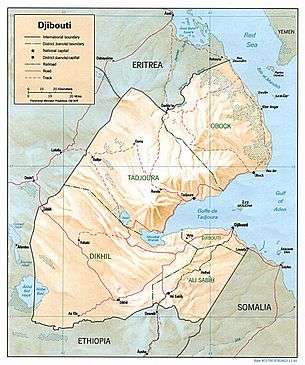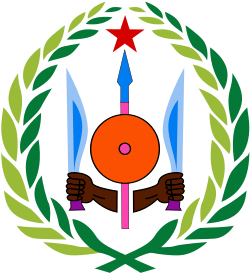Djiboutian Civil War
| Djiboutian Civil War | |||||||
|---|---|---|---|---|---|---|---|
 Map of Djibouti | |||||||
| |||||||
| Belligerents | |||||||
|
Supported by: |
| ||||||
| Commanders and leaders | |||||||
|
|
| ||||||
| Strength | |||||||
|
5,000 (1992) 20,000 (1994)[1] |
3,000 (1991) 4,500 (1994) | ||||||
| Casualties and losses | |||||||
| Unknown | 1,000 killed[2] | ||||||
The Djiboutian Civil War (also known as the Afar insurgency) was a conflict in Djibouti, lasting from 1991 to 1994 and resulting in thousands of fatalities.[3] This uneven power sharing between the Issas and Afars led to the Civil War that ravaged the country for three long years.
Background
Since at least French rule, first as French Somaliland and then as French Territory of the Afars and the Issas, there have been ethnic tensions in Djibouti between the Issas, and the Afars. Following independence in 1977, the Issas-dominated People's Rally for Progress party had ruled Djibouti, and since 1981, had ruled it as a one-party state with the People's Rally for Progress the only authorized party. Many Afar felt marginalized.
At the same time, in 1991, neighboring countries' authoritarian governments were overthrown, Siad Barre in Somalia and Mengistu Haile Mariam in Ethiopia. Eritrea also became independent from the People's Democratic Republic of Ethiopia in 1991.
Outbreak
In May 1991, thousands of Ethiopian soldiers routed into Djiboutian territory after the Derg government of Ethiopia was overthrown. Framed by French and Djiboutian troops, they are repatriated back to Ethiopia, but leaving many weapons behind them. At the beginning of October 1991, the rebel organization Front for the Restoration of Unity and Democracy (FRUD), calling for greater political participation of Afar, launched a guerrilla struggle against the government. There were clashes between government forces and FRUD rebels in the Dikhil region of western Djibouti on October, from the first days of the outbreak of hostilities, specifically on the night of 15–16 November 1991, the Djiboutian Army captured some 232 individuals in the Obock Region. These were mainly the Afars of Eritrea and the militia of the former Derg regime. To wash away the affront, the FRUD launches on 21 November 1991 to the assault of the town of Obock and its garrison, after a long day of fierce fighting, the Djiboutian soldiers crushed them and won the battle. Subsequently, several other battles will confront the national army and the Frud militia, which caused heavy casualties on both sides. The rebel (FRUD) seized all military posts in the north of the country and laid siege to the city of Tadjoura and Obock. The government troops and FRUD rebels clashed near Tadjoura on January 3–4, 1992, resulting in the deaths of some 150 rebels and three soldiers and government troops and FRUD rebels clashed in the Gagade, Kharab, and Bekaneb districts on 17–18 January 1992, resulting in the deaths of some 150 rebels and 16 soldiers. Throughout the war, the fighting was mainly in the north of the country with the exception of the incident in the capital, when the December 18, 1991 the year the government troops entered the area Arhiba inhabited by the Afar, and opened fire on crowds of people. At the same time killed at least 59 people.[4][5] In February 1992, some French troops were deployed in the north to aid the government forces.[6] With about 3000 (FRUD) rebel attacked a government institutions in Dikhil but was repelled back. France has tried to mediate between the government and the rebels, but all attempts to organize such talks (November 1992, May 1993 the year ) failed.[7] The government responded by increasing its armed forces from about 5,000 to 20,000 men and recalled its reserves, they were supported with some military equipment by France. On the 5 July 1993, government troops went on the offensive, capturing most of the rebel-held areas. Some 10,000 to 18,000 of Djiboutians fled the fighting in the neighboring Afar Region of Ethiopia.[8] The Civil War contributed to the reintroduction of a multi-party democracy in 1992 with a new constitution. In 1992 and 1993 parliamentary and presidential elections took place. Subsequently, the FRUD split on the question of how far it was to cooperate with the government. But guerrilla actions continue to unfold, the opposition denounces numerous abuses against civilians.
Peace agreement
In December 1994, the Abb'a peace agreement between the government and the moderate majority of FRUDs largely ended the civil war. Two FRUD representatives received ministerial posts, and at the next 1999 elections the FRUD supported the RPP, re-constituted themselves as a political party and some 200 of their adherenets was integrated in the civil service and local administration and almost 700 of fighters joined regular army.[9] A faction of the rebels, led by Ahmed Dini continue low-scale insurgency over the next few years, being especially visible in the 1996. In December 2000 this faction also signed a cease-fire and took five government posts. Accordingly, to the words of agreement, administrative reform were ensued soon after.
See also
References
- ↑ http://dosfan.lib.uic.edu/ERC/democracy/1993_hrp_report/93hrp_report_africa/Djibouti.html
- ↑ http://www.systemicpeace.org/warlist/warlist.htm
- ↑ "Djibouti army reports 100 rebels killed." The Associated Press, January 19, 1992.
- ↑ Perlez, Jane (December 20, 1991). "Soldiers Fire Into Crowd in Djibouti Tribal Strife". The New York Times.
- ↑ "Pour la 12ème commémoration du massacre d'Arhiba" (in French). Les nouvelles d'Addis.
- ↑ "250 French Troops Sent to Djibouti War Zone." Associated Press, February 25, 1992.
- ↑ "Rebels turn down president's terms for negotiations." Agence France Presse, May 10, 1993
- ↑ "Thousands Of Djiboutians Flee to Ethiopia." The Associated Press, July 12, 1993.
- ↑ "Djibouti". U.S. Department of State.
